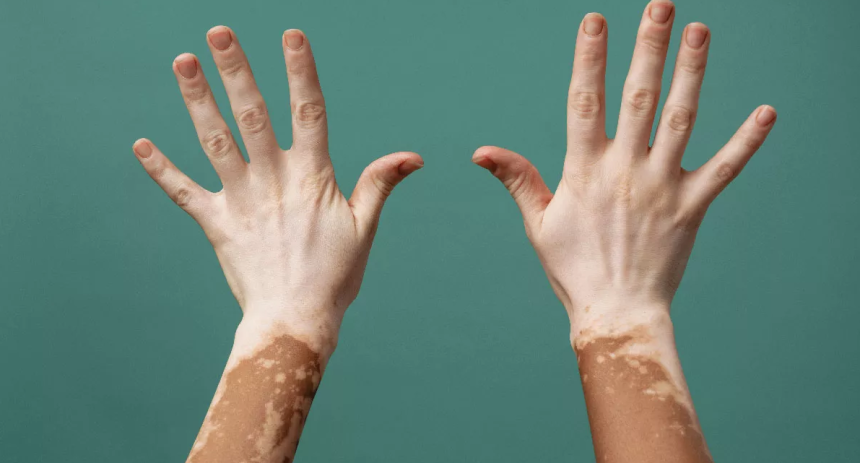Vitiligo, a condition that leads to the loss of skin colour in patches, affects millions of people worldwide. It transcends geographical boundaries and social strata, leaving those afflicted with both physical and psychological challenges. Understanding vitiligo is essential for fostering a compassionate society that supports those who live with this condition.
Prevalence of Vitiligo
Vitiligo affects approximately 1% of the global population, translating to around 70 million people worldwide. In India, the prevalence is notably higher, with studies indicating a range of 0.5% to 2.5% of the population, depending on the region. This disparity underscores the need for targeted research and awareness programs tailored to different demographics.
Types of Vitiligo
Vitiligo can be broadly categorized into two main types:
- Non-Segmental Vitiligo (NSV): This is the most common form, characterized by bilateral symmetrical white patches on various parts of the body. It often progresses over time and can affect large areas of the skin.
- Segmental Vitiligo (SV): Less common, this type appears in a segmental pattern, usually affecting one side of the body. It typically develops at a younger age and stabilizes within a year or two.
Additionally, vitiligo can be classified based on its stability:
- Stable Vitiligo: This form does not show new lesions or progression for at least six months. Stability is crucial for certain treatments, such as surgical interventions, which are more successful when the condition is not actively spreading.
- Unstable Vitiligo: This form is characterized by the appearance of new lesions and the spread of existing patches. Management of unstable vitiligo focuses on halting the progression of the disease.
Social Stigma: Vitiligo carries a significant social stigma, particularly in cultures where physical appearance is heavily scrutinized. Individuals with vitiligo often face discrimination, bullying, and social isolation. The psychological impact can be profound, leading to issues such as anxiety, depression, and low self-esteem. Efforts to educate the public and promote acceptance are crucial in mitigating these adverse effects.
Treatment Options
While there is no cure for vitiligo, various treatments can help restore skin color and improve the appearance of affected areas. These treatments can be grouped into four main categories:
- Topical Treatments:
- Corticosteroids: These are often the first line of treatment. They help reduce inflammation and can induce repigmentation in some patients. A recent study showed that about 56% of patients treated with topical corticosteroids experience some degree of repigmentation.
- Calcineurin Inhibitors: These include tacrolimus and pimecrolimus. They are particularly useful for sensitive areas like the face and have fewer side effects compared to corticosteroids. Clinical trials have demonstrated significant repigmentation in 45-50% of cases.
- Janus Kinase (JAK) Inhibitors: A newer class of drugs, JAK inhibitors, such as tofacitinib, have shown promising results in early clinical trials, with some patients experiencing substantial repigmentation.
- Topical MSHA (Melanocyte-Stimulating Hormone Analog) activates melanocytes and enhances melanin transfer. Early studies show it can induce repigmentation, especially when combined with other therapies like phototherapy. It is generally well-tolerated, with minimal side effects such as local irritation or redness. Both treatments offer potential for targeted vitiligo management.
- Topical bimatoprost is promising for treating localized vitiligo, especially around the eyes. It stimulates melanin production and melanocyte activity through prostaglandin receptors. It is often used with UVB phototherapy for better results. Side effects include local irritation and increased pigmentation around the treated area.
- Oral Medications:
Corticosteroids: In cases of rapidly spreading vitiligo, oral corticosteroids can be used to stabilize the disease. However, long-term use is limited due to potential side effects.
- Immunosuppressants: Drugs like methotrexate or azathioprine can be considered for extensive vitiligo, although their use is often limited to severe cases due to side effects and the need for regular monitoring.
- JAK Inhibitors: Oral JAK inhibitors (Tofacitinib) are also being explored, with recent studies indicating their potential to halt disease progression and induce repigmentation.
- Apremilast: An oral phosphodiesterase 4 (PDE4) inhibitor, Apremilast has shown potential in treating vitiligo by modulating the immune response and reducing inflammation. A 2021 study published in Dermatology and Therapy reported that Apremilast led to significant repigmentation in patients with vitiligo, particularly when combined with phototherapy. The exact mechanism involves the reduction of pro-inflammatory cytokines, which are believed to contribute to the progression of vitiligo.
- Light and Laser Treatments:
- Narrowband UVB (nbUVB) Therapy: This is the most commonly used phototherapy for vitiligo. It involves exposing the skin to UVB light, which can stimulate melanocytes (pigment-producing cells) to repopulate the affected areas. Studies indicate that nbUVB therapy can lead to significant repigmentation in 60-70% of patients.
- Excimer Laser: This treatment uses a concentrated form of UVB light and is effective for localized vitiligo. Clinical trials have shown that excimer laser can achieve repigmentation in up to 70% of treated areas, particularly when combined with topical therapies.
- Fractional CO2 Laser with Topical 5-Fluorouracil: The fractional CO2 laser creates microscopic wounds in the skin, promoting the absorption and efficacy of topical treatments. When combined with topical 5-fluorouracil, it can enhance repigmentation by stimulating melanocyte migration and proliferation.
- Photodynamic Therapy (PDT): An emerging treatment option, PDT combines light-sensitive drugs with light exposure to target affected skin. Preliminary studies suggest it may enhance repigmentation, though more research is needed.
- Camouflage Techniques:
- Cosmetic Cover-ups: Products such as makeup, self-tanners, and skin dyes can provide immediate concealment. Brands have developed specialized products that are long-lasting and water-resistant, helping individuals with vitiligo feel more confident.
- Micropigmentation: Also known as medical tattooing, this technique involves implanting pigment into the skin to match the surrounding area. It is particularly useful for stable vitiligo and has shown promising long-term results.
- Skin Grafting: In cases of stable vitiligo, skin grafting from normally pigmented areas can be used to cover depigmented patches. Surgical treatments, including melanocyte transplantation, offer significant repigmentation, especially for localized vitiligo.
- Depigmentation Therapy:
- When to Consider: Depigmentation therapy is typically considered for individuals with extensive vitiligo affecting more than 50% of their body. It is an option when repigmentation therapies are ineffective or undesirable. This method aims to achieve a more uniform skin tone by removing the remaining pigment from unaffected areas.
- Methods: The primary agent used for depigmentation is monobenzyl ether of hydroquinone (MBEH). This topical treatment gradually lightens the remaining pigmented skin over several months. Another approach includes using Q-switched Nd:YAG lasers, which target the pigment cells more precisely and can accelerate the depigmentation process. These lasers disrupt the melanin in the skin, leading to more effective and faster depigmentation compared to topical treatments alone.
What’s New in Vitiligo Treatment
Recent advancements in vitiligo treatment have focused on improving efficacy and reducing side effects. Some notable developments include:
- Opzelura (Ruxolitinib): In 2022, the FDA approved ruxolitinib cream, a JAK inhibitor, for the treatment of non-segmental vitiligo in adults and adolescents. Clinical trials showed that around 50% of patients achieved significant repigmentation after 24 weeks of treatment.
- Afamelanotide: This synthetic analog of alpha-melanocyte-stimulating hormone (α-MSH) is being studied for its potential to stimulate melanogenesis. Early results have shown promising repigmentation in patients undergoing nbUVB therapy.
Diet and Vitiligo
According to the American Academy of Dermatology (AAD), there is no definitive scientific evidence linking specific foods to the improvement or worsening of vitiligo. However, some dietary considerations may help in managing the condition:
Foods to Avoid
- Gluten: Some patients report improvement after eliminating gluten from their diet, although scientific evidence is limited.
- Dairy: Reducing dairy intake may benefit some individuals, particularly those with lactose intolerance.
- Processed Foods: Avoiding foods high in preservatives, additives, and artificial colors might help reduce oxidative stress and inflammation.
Foods to Prefer
- Antioxidant-Rich Foods: Foods high in antioxidants may help reduce oxidative stress, which is thought to contribute to the progression of vitiligo. These include:Fruits and vegetables, especially those rich in vitamins A, C, and E (such as berries, citrus fruits, leafy greens, and nuts).Foods rich in polyphenols like green tea and dark chocolate.
- Foods High in Beta-Carotene: Carrots, sweet potatoes, and other orange and yellow fruits and vegetables can be beneficial due to their high beta-carotene content.
- Foods Containing Omega-3 Fatty Acids: Fatty fish (like salmon and mackerel), flaxseeds, and walnuts help reduce inflammation and support overall skin health.
- Zinc-Rich Foods: Zinc supports immune function and skin health. Good sources include beans, nuts, seafood, and whole grains.
Debunking Myths about Vitiligo
There is a pressing need to debunk the many myths surrounding vitiligo. Here are seven common misconceptions and the truths behind them:
- Myth: Vitiligo is contagious.
Truth: Vitiligo is not infectious and cannot be spread through contact.
- Myth: Vitiligo is caused by eating certain foods like curd and fish together.
Truth: There is no scientific evidence to support that consuming certain food combinations, such as curd and fish together, causes vitiligo. The exact cause of vitiligo is unknown, but it is believed to involve genetic, autoimmune, and environmental factors.
- Myth: Vitiligo only affects people with dark skin.
Truth: Vitiligo can affect individuals of any skin color, although it is more noticeable in those with darker skin.
- Myth: Every White Spot on Skin is Vitiligo.
Fact: Not all white spots are vitiligo; other conditions like pityriasis versicolor, post-inflammatory hypopigmentation, and idiopathic guttate hypomelanosis can also cause similar spots. Proper diagnosis by a healthcare professional is essential.
Conclusion
Vitiligo is more than just a skin condition; it is a journey of resilience and self-acceptance. By fostering understanding and compassion, society can help those affected by vitiligo to lead fulfilling lives. Embrace your unique beauty, and remember that true strength lies in our differences. With continued research and awareness, the future holds promise for even more effective treatments and broader acceptance.
“Our uniqueness is our strength; in our differences, we find beauty.”
(The Author is MBBS,MD; Director & Founder, DERMIS – Skin & Hair Clinic Bemina, Srinagar. Feedback: [email protected])








